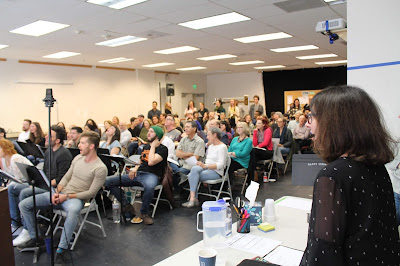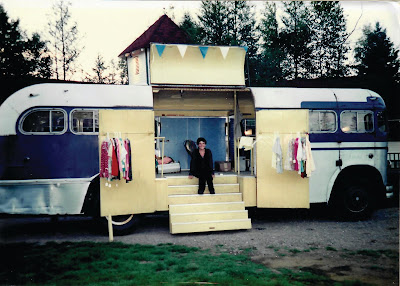Writing from Memory: An Interview with A Walk on the Moon Book Writer Pamela Gray
By Taylor Steinbeck
Every summer from age three to fifteen, Pamela Gray was whisked away from the hubbub of New York City to the Catskill Mountains. Paying $250 for the entire season, Gray’s family lived with other working-class Jewish families in bungalow colonies. “These Jewish housewives lived in this matriarchal world,” says Gray, “where they’d be visited by vendors: the blouse man, the dress man, the bathing-suit man.” Seeing the storytelling potential in these childhood memories, Gray wrote about ’60s Borscht Belt life in her first screenplay, The Blouse Man, which later became the movie A Walk on the Moon (1999). More than ten years later, producers approached her to adapt Moon into a musical; she leaped at the opportunity. Before rehearsals in San Francisco, Gray reminisced with us about the Catskills, Woodstock, and the process of creating a new musical.
 |
| Book writer Pamela Gray at the first rehearsal of A.C.T.'s 2018 production of A Walk on the Moon. Photo by Taylor Steinbeck. |
In the summer of 1969, your family was just a few miles from where the Woodstock Music & Art Fair took place. How conscious were you of the festival?
Nobody in the bungalow colonies really knew what Woodstock was going to be, but there was an awareness that this other world was encroaching. I was a fan of the musicians performing and, since friends were going, I asked my mother if I could. She initially said okay, but then she came over to me a couple weeks later and said, “Do you know the National Guard might be there? You are not going to that concert!” Other kids from the colony snuck out, but I didn’t have the nerve.
Why do you think this musical will resonate with today’s San Francisco audience?
A Walk on the Moon begins at A.C.T.’s Geary Theater June 9. Click here to purchase tickets. Want to learn more about how book writer Pamela Gray’s childhood memories inspired Moon? Order a copy of Words on Plays, A.C.T.'s in-depth performance guide series.
Nobody in the bungalow colonies really knew what Woodstock was going to be, but there was an awareness that this other world was encroaching. I was a fan of the musicians performing and, since friends were going, I asked my mother if I could. She initially said okay, but then she came over to me a couple weeks later and said, “Do you know the National Guard might be there? You are not going to that concert!” Other kids from the colony snuck out, but I didn’t have the nerve.
Why do you think this musical will resonate with today’s San Francisco audience?
A lot of what happened in the summer of ’69 wouldn’t have happened without 1967’s Summer of Love. Even though this story takes place on the East Coast, its themes of transformation and revolution capture the energy of the Bay Area.
The 1960s was an era similar to today when teenagers had a stake in what was happening politically. I’ve heard young gun control activists from Parkland, Florida, saying, “People of our age group haven’t had a voice since the ’60s.” Just like the kids of today, the kids in the ’60s didn’t trust their government, but they didn’t believe they were powerless. In Moon, Alison says that Woodstock is going to end the war in Vietnam. There was this belief in the power of youth.
What have you enjoyed most about the process of creating a new musical?
The collaboration has been thrilling. As a creative person, I can’t think of anywhere I’d rather be than sitting in a room with smart, talented people and hearing everyone’s ideas. I love that every artist is seeing the story through the lens of craft. The cast and creative team showed me things about this story—a story that is in my DNA—that I hadn’t seen before.
The collaboration has been thrilling. As a creative person, I can’t think of anywhere I’d rather be than sitting in a room with smart, talented people and hearing everyone’s ideas. I love that every artist is seeing the story through the lens of craft. The cast and creative team showed me things about this story—a story that is in my DNA—that I hadn’t seen before.


